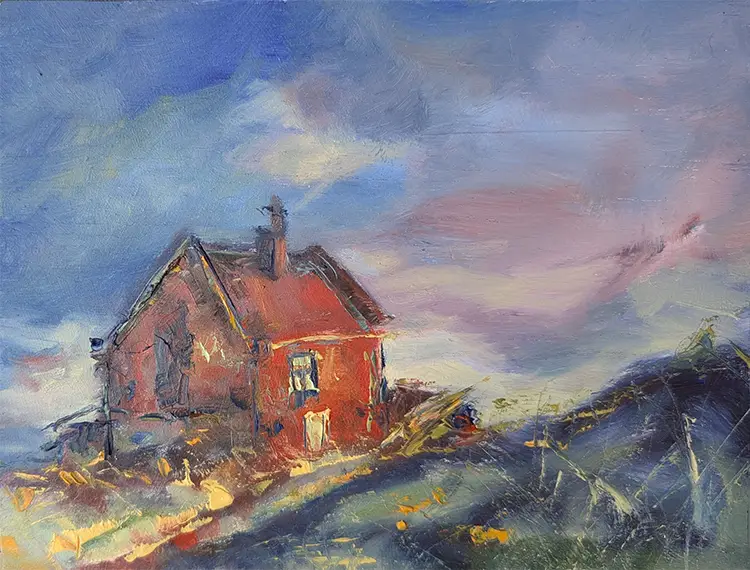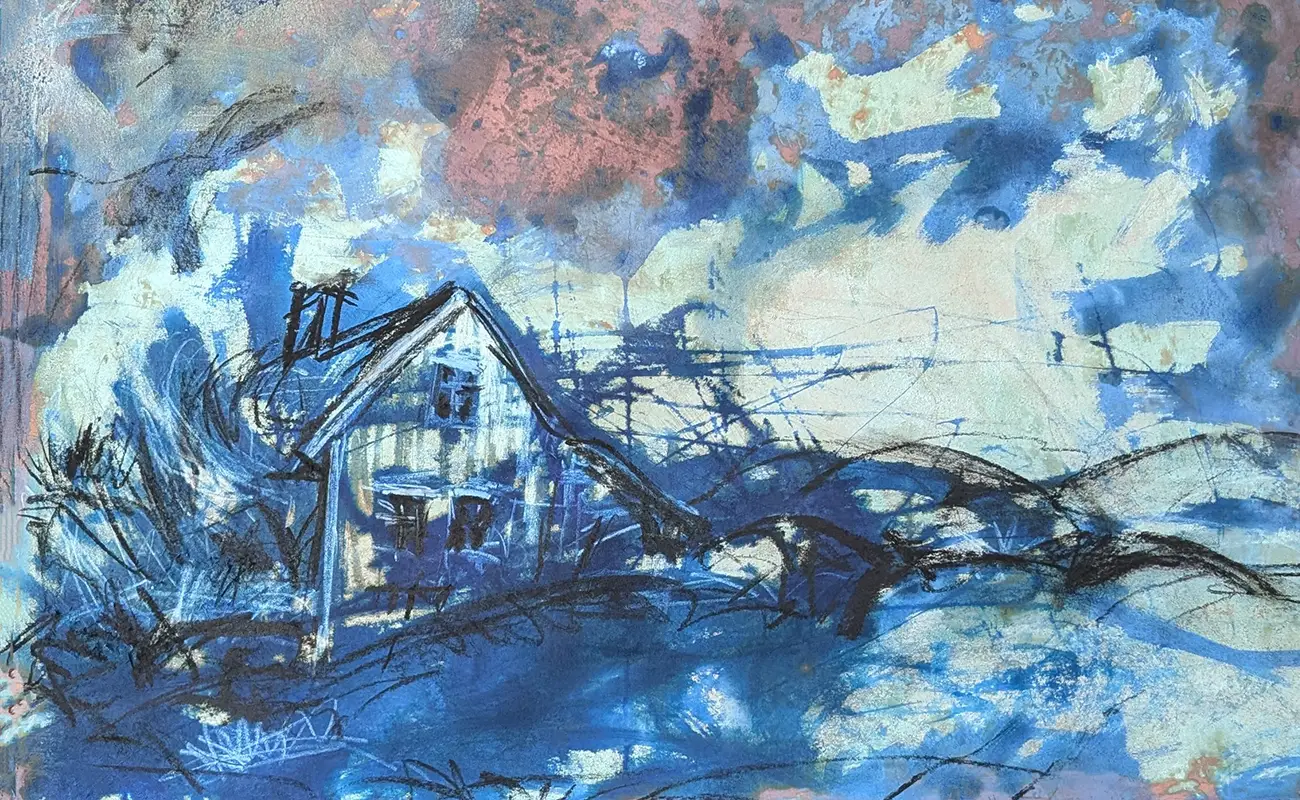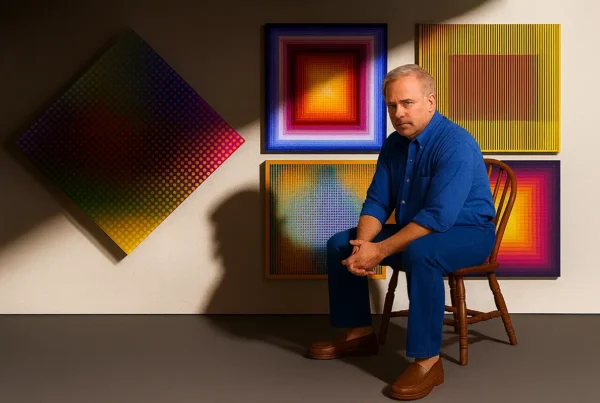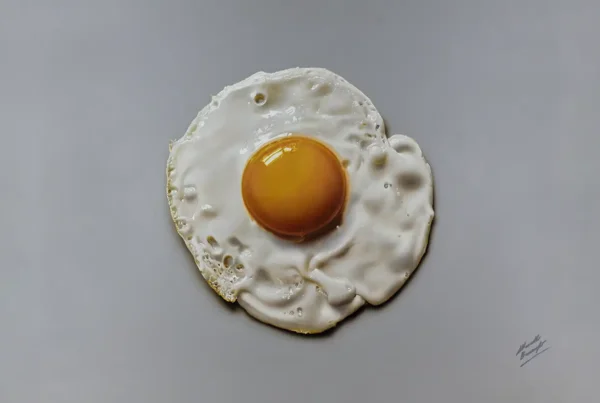“Art is not a solution, but a place where the act of searching itself is given value.”
Born of Wind and Wonder
The art of LACE Ruig stirs from deep within landscapes both physical and emotional. Her roots lie along the Dutch coastline, where bulb fields stretch to the sea and the wind carries stories older than memory. The southwestern storms of her youth, often watched from the beach during spring tides with her father and brother, left an enduring imprint. That intense, chaotic beauty of nature, with its primal force and unpredictable rhythm, pulses through her work, not as passive scenery but as a central figure—both challenger and companion to the human presence. Nature is not conquered nor subordinated, but engaged in a powerful dance with the fragile structures we build against it.
This perspective becomes especially vivid in her Icelandic Houses series, where architecture and environment enter into a compelling dialogue. The house in these works is neither victorious nor defeated; instead, it holds its own as part of a greater rhythm. The visual interplay underscores a coexistence rather than a dichotomy, emphasizing how human structures must yield to natural elements without entirely surrendering. The boundaries blur—resistance becomes resilience, and what appears fragile may in fact be enduring. Her compositions evoke a sense of watching and being watched by the land itself, suggesting that we are not outside of nature, but enmeshed within it.
Stories, too, form the bones of Ruig’s creative identity. Her father’s tales were more than bedtime rituals—they became the seeds of a symbolic language that runs through much of her work. In her It’s Nature series, figures such as Deer/Hert are imbued with human significance, not as characters but as presences. Vulnerable and alert, they stand at the threshold between instinct and metaphor. In this space, nature is not background noise but mirror and mentor. Her pieces explore the tension between civilization and wildness, control and chaos, always circling the idea that the most vital truths emerge in moments of unguarded exchange between the seen and the unseen.
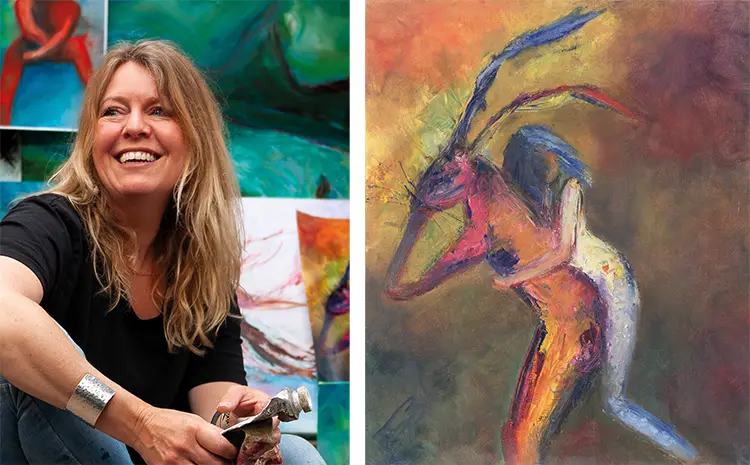
LACE Ruig: Symbols That Breathe
Ruig’s approach to artistic creation is less about control and more about communion. Her style resists rigid planning, favoring instead a layered, intuitive process. She rarely begins with a fixed blueprint, allowing the work to unfold according to emotional cues and visual prompts. Recurring motifs—hares, houses, lines carved in soil, and fences—carry symbolic weight far beyond their surface. These are not decorative elements but vessels of meaning, each representing an inner or collective human state. The hare might suggest alertness or vulnerability, the fence a boundary both real and metaphorical. Nothing in her work is purely representational; every form is charged with suggestion.
Themes of femininity, resilience, impermanence, and internal flux weave through her pieces like a quiet refrain. Ruig doesn’t shy away from contradiction—in fact, she welcomes it. Strength and fragility, movement and stillness, clarity and confusion coexist within her imagery. These themes do not arrive with answers but open space for reflection. Her work is not about instructing the viewer but inviting them into a visual dialogue, a silent conversation in which meaning emerges through association rather than assertion. For Ruig, the greatest success is not aesthetic harmony, but emotional resonance—when a piece triggers memory, insight, or even discomfort in the person who encounters it.
Her admiration for artists like Louise Bourgeois and Anselm Kiefer is telling. Like Bourgeois, she values raw honesty, and like Kiefer, she is deeply invested in the materiality of her work. Yet her influences also stretch into literature. Kafka’s Der Prozess exposed the oppressive architecture of bureaucratic systems, while Bordewijk’s Bint sparked lifelong questions about authority and order. These literary experiences didn’t just enrich her intellectual world—they altered her artistic compass. Rather than controlling chaos through discipline, she seeks meaning in its folds. In confusion and intensity, she finds the pulse of creativity. Freedom is not just a theme for Ruig; it is the condition under which her work breathes.
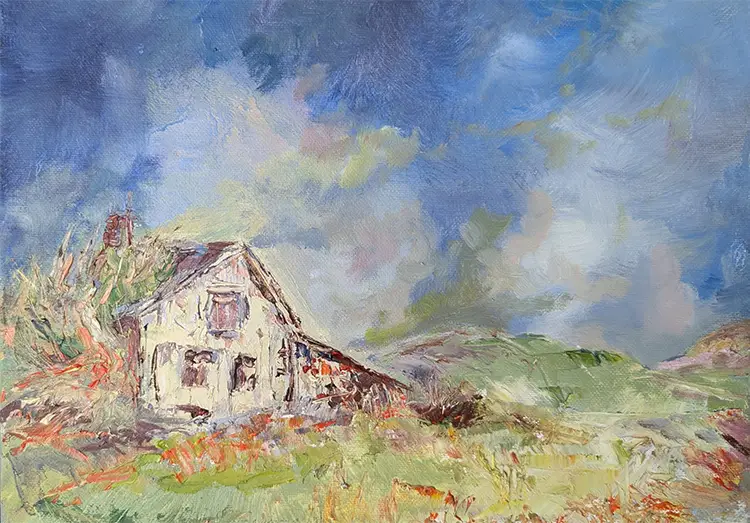
The Studio as Threshold
Ruig’s workspace is not defined by square footage or décor, but by the atmosphere it allows her to inhabit. Her studio serves as both physical refuge and mental anchor—a place where materials can rest and ideas can stir. But she is not confined to its walls. She often shifts to her garden or a shed when the process demands a different kind of intimacy or quiet. The crucial element is a sense of protection, a shield that allows her to remain connected to the inner movement that drives her creative output. That shield can be a silent room, a stretch of solitude, or simply the absence of judgmental eyes. Though once drawn to the dance floor’s crowd, she now prefers the isolation of her artistic ritual.
Noise, like silence, is part of her rhythm. Some days are shaped by thunderous music, others by absolute stillness. What remains constant is her need for solitude. She doesn’t seek isolation for its own sake, but as a necessary condition for the emergence of work that is honest and alive. Distraction, once an adversary, has now become a reluctant collaborator. Rather than resisting it, she weaves it into the process, recognizing that disturbances sometimes carry their own insights. Her ideal day is one in which she can fully disappear into the work, letting time dissolve into focus—a state where thought, emotion, and gesture flow without friction.
One piece that encapsulates this intimate dynamic is Hare. It is not merely a visual object but a distillation of sensation, a translation of what she observes and experiences in her environment. Likewise, her Budapest Hotel series grew out of personal experience and carries the emotional weight of lived moments. For Ruig, the significance of an artwork is not sealed at the point of creation—it expands through what it awakens in others. During exhibitions, she cherishes the responses of viewers, especially when their interpretations differ from her own. In those interactions, where empathy and interpretation intersect, the artwork is reborn. It is in those exchanges that the work gains new dimensions and continues to evolve.
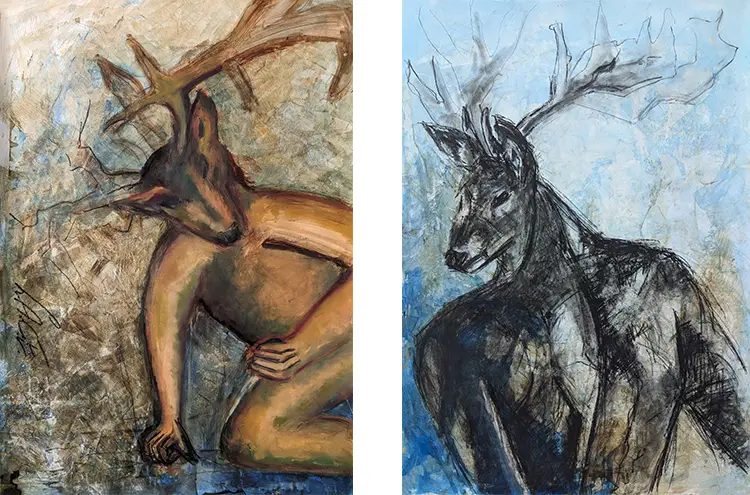
LACE Ruig: Chaos as Fertile Ground
Ruig’s materials are not chosen for convenience or fashion—they are felt. Charcoal, in particular, has become an extension of her hands. Its tactile immediacy, its rawness, allows her to transmit emotion directly onto the surface. She rarely sketches with tools at a distance; instead, she touches, smears, and blends with her fingers, making the act of creation a bodily engagement. Each medium she uses becomes part of the conversation between idea and execution. The piece does not adapt to the medium; the medium rises to meet the need of the piece.
Her relationship with material is deeply adaptive. If an idea calls for unfamiliar tools or techniques, she does not hesitate to dive into research and experimentation. Recently, she has begun to explore three-dimensional forms, aiming to bring a tactile, spatial presence to themes that have long lived on paper or canvas. Her studio, once a sanctuary, now doubles as a laboratory where questions are tested in wood, clay, and other malleable substances. Collaborating with specialists in material design, she is slowly giving shape to a long-held dream: to create a public sculpture that engages viewers not just visually but emotionally and intellectually.
This ambition speaks to her broader vision—art that serves as more than an object, but as an invitation. She envisions work that doesn’t simply exist in space, but activates it. Pieces that unsettle, nourish, or provoke thought. In a world increasingly ruled by division, noise, and control, she wants to craft works that return people to their internal compass. She believes feeling is the new thinking. By layering symbolism and raw experience, she seeks to build bridges between the solitary and the shared, between vulnerability and strength. Her art does not shout. It listens. And in that quiet, it asks you to listen too.
